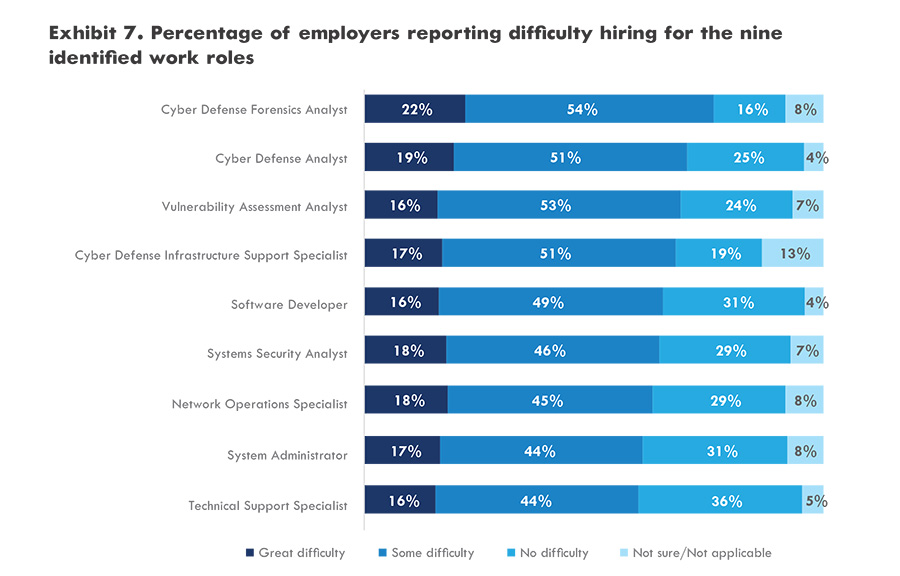As many as 35,000 cybersecurity-related annual job openings in California will need to be filled in the near future, a new research paper asserts, but “an alarming gap” will soon emerge if educational programs fail to train new workers.
California's Governor's Office of Business and Economic Development (GO-Biz), in conjunction with the Governor's Office of Planning and Research (OPR), released the results of a California Cybersecurity Labor Market Analysis and Statewide Survey last week.
This document details the findings of a study done by the California Community Colleges Centers of Excellence for Labor Market Research and demonstrates that there is much work to be done in order to adequately prepare Californians for the demands of the digital and cyber economy.
Conducted as part of the California Advanced Supply Chain Analysis & Diversification Effort (CASCADE) initiative funded by the U.S. Department of Defense, the study gathered information about workforce needs in California and the scope of training being provided by educational providers across the state.
“The Cybersecurity Labor Market Analysis is a major step forward in understanding the significant gap between the demand for cybersecurity-related occupations and number of qualified candidates in the state,” said GO-Biz Director Panorea Avdis. “As California's companies rely more on digital technologies, addressing this labor shortfall becomes more urgent. We look forward to working with public and private partners to identify and implement solutions that support California businesses.”
The lead author for the report, John Carrese, told SCMR in an interview that the familiar “trope” of high-tech corporations leaving California for states offering lower total landed costs is not relevant.
“Consider that the nation's fastest growing companies still get there start in California is an important fact to consider,” he said. “And that trend is simply ballooning.”
In order to complete this analysis, a statewide survey of 385 businesses was conducted to collect data for nine of the most common cybersecurity occupations, using the National Initiative for Cybersecurity Education (NICE) Cybersecurity Workforce Framework.
This included roles such as Systems Security Analyst, Cyber Defense Analyst, Vulnerability Assessment Analyst, Cyber Defense Forensics Analyst, and Software Developer, among others. Additionally, as part of the study, primary and secondary data was collected on public and private postsecondary institutions offering cybersecurity related programs.
Based on employer responses, strong cybersecurity employment growth is expected over the next 12 months, ranging from 4% to 21% for the work roles studied, representing an increase of about 14,300 positions. In 2016, the most recent year of available data, 242 accredited postsecondary institutions in California offered 1,177 programs that were related to cybersecurity. However, only 3,200 awards were conferred by programs that focused directly on cybersecurity or clearly included aspects of cybersecurity in their curriculum. The study concludes that California's educational institutions are not currently supplying enough qualified candidates to fill the thousands of cybersecurity job openings that exist.

Eileen Sanchez, CASCADE Program Manager said, “These numbers show a real opportunity to train individuals into high growth occupations. Knowing what occupations and skills are most important is a key factor in re-training defense workers and getting them to adapt to national security priorities and the changing skills requirements of jobs in our economy here in California.”
She told SCMR that now managers have an opportunity to align transportation, logistics, and cybersecurity, to create chairs and curriculum at today's universities.
“It happens on the ground,” and then cuts across all spectrums,” she added.
SC
MR


Latest Supply Chain News
- How CPG brands can deliver on supplier diversity promises
- How S&OP provides the answer to in-demand products
- AI, virtual reality is bringing experiential learning into the modern age
- Humanoid robots’ place in an intralogistics smart robot strategy
- Tips for CIOs to overcome technology talent acquisition troubles
- More News
Latest Podcast

 Explore
Explore
The Academy News
- AI, virtual reality is bringing experiential learning into the modern age
- Predicting stockouts: Enhancing FMCG resilience through data-driven insights
- Finding the Right Approach for Supply Chain Education
- The Supply Chain Triad
- Innovating Supply Chain Higher Education with Generative AI
- How Smart Supply Chain Management Boosts Brand Identity
- More The Academy
Latest Academy Resources

Subscribe

Supply Chain Management Review delivers the best industry content.

Editors’ Picks





